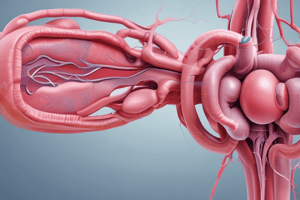Podcast
Questions and Answers
What is the unique feature of the renal arterioles in the kidney?
What is the unique feature of the renal arterioles in the kidney?
- They interconnect with other terminal arteries
- They directly connect to the aorta
- They subdivide into a capillary bed and become an arteriole again (correct)
- They supply blood to all organs in the body
What percentage of the blood leaving the left ventricle enters the kidneys via the renal arteries?
What percentage of the blood leaving the left ventricle enters the kidneys via the renal arteries?
- 20-25% (correct)
- 70-75%
- 5-10%
- 40-45%
What is the approximate rate at which blood passes through the kidneys in a normal adult?
What is the approximate rate at which blood passes through the kidneys in a normal adult?
- 1500 mL per minute
- 800 mL per minute
- 1000 mL per minute
- 1200 mL per minute (correct)
Which artery supplies blood to the glomerulus of each nephron?
Which artery supplies blood to the glomerulus of each nephron?
What does the efferent arteriole branch into after leaving the glomerulus?
What does the efferent arteriole branch into after leaving the glomerulus?
Which type of nephron has peritubular capillaries that wrap around its tubules entirely?
Which type of nephron has peritubular capillaries that wrap around its tubules entirely?
What role does renin play in regulating blood flow?
What role does renin play in regulating blood flow?
Where does the blood flow after leaving the peritubular capillaries in the juxtamedullary nephrons?
Where does the blood flow after leaving the peritubular capillaries in the juxtamedullary nephrons?
What is the function of the vasa recta in juxtamedullary nephrons?
What is the function of the vasa recta in juxtamedullary nephrons?
What is the significance of the proximity of renal tubules and peritubular capillaries?
What is the significance of the proximity of renal tubules and peritubular capillaries?
Flashcards are hidden until you start studying
Study Notes
Renal Arterioles
- The unique feature of renal arterioles is that they are capable of autoregulation, allowing them to maintain a constant blood flow to the kidneys despite changes in blood pressure.
Blood Flow to the Kidneys
- Approximately 20-25% of the blood leaving the left ventricle enters the kidneys via the renal arteries.
Renal Blood Flow Rate
- In a normal adult, blood passes through the kidneys at a rate of approximately 1.2 liters per minute.
Glomerulus Blood Supply
- The afferent arteriole supplies blood to the glomerulus of each nephron.
Efferent Arteriole
- After leaving the glomerulus, the efferent arteriole branches into a network of peritubular capillaries that surround the renal tubules.
Nephron Types
- Juxtamedullary nephrons have peritubular capillaries that wrap around their tubules entirely.
Renin Regulation
- Renin plays a role in regulating blood flow by stimulating the production of angiotensin II, a potent vasoconstrictor.
Juxtamedullary Nephron Blood Flow
- After leaving the peritubular capillaries in juxtamedullary nephrons, the blood flows into the vasa recta.
Vasa Recta Function
- The vasa recta in juxtamedullary nephrons act as countercurrent exchangers, helping to maintain the osmotic gradient necessary for urine concentration.
Renal Tubules and Peritubular Capillaries
- The proximity of renal tubules and peritubular capillaries allows for efficient reabsorption and secretion of substances into the bloodstream.
Studying That Suits You
Use AI to generate personalized quizzes and flashcards to suit your learning preferences.




